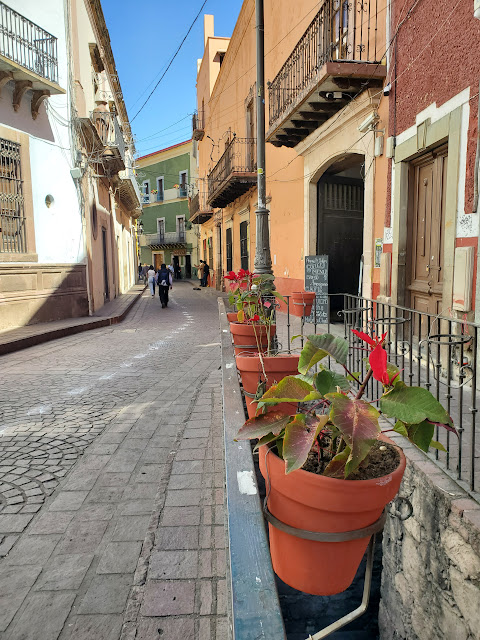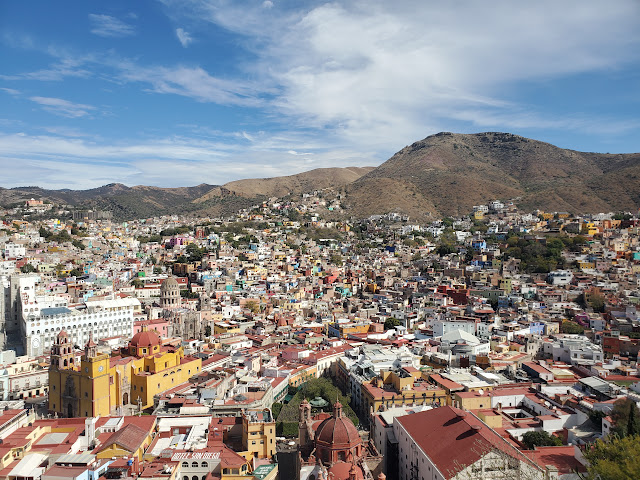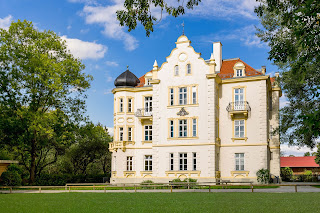Contemplating the Bittersweet
Life in Guanajuato has begun to feel quite normal. I’m settling in, and I like it. It’s a good feeling to have found a community that feels welcoming, positive, energetic and that’s filled with interesting, caring, curious people. It’s home to 200,000 inhabitants, but Guanajuato feels much more like a small town than a big city, and since I keep myself mostly to the southern half of the city - the slightly quieter part - it feels even more so like my own little pueblo. I can get everywhere within the city center on foot, and much of “el centro” is traffic free thanks to the many tunnels below ground, constructed over the past centuries as a way to divert river water from the silver mines that brought riches to Spain and to prevent flooding in the city. The tunnels have since been expanded - the silver mines much a relic of the past - and turned into motorways, making traffic clogs a relative scarcity within the center of town.
You won’t be surprised to read that I’m once again writing from a coffee shop - this time from DOCH Cafe on calle De Sopena, one of the many aforementioned quaint, beautiful pedestrian only streets in el centro. This time of day - around 11:00 a.m. - the street is quiet. Later in the day, it becomes much busier with buskers belting out guitar-heavy tunes, restaurant barkers begging tourists to enter their establishments and jewelry makers spreading their wearable art on sidewalk blankets. People steadily stroll by, many making eye contact with me as they peer in and I peer out, from my seat at the table nearest the door. The narrow, cobblestone street is blanketed in the shade of the tightly packed, three-story buildings that line it up and down, even though the sun is shining and the sky is a bright blue. Slow, smooth, English language hip-hop - the lyrics of which are filled with an extraordinarily large amount of F-bombs - pumps from a speaker on the wall to my left. A group of three locals sits next to me, as the barista works the cappuccino machine. I just asked him the significance of the word, “DOCH.” He told me it’s a German word, and as best as I could understand from his Spanish explanation, the owner of the coffee shop had heard this word while in Germany and thought it perfectly described her efforts to try to open up this shop, when she wasn’t sure it would ever become a reality. “Doch” means “but or yet or nevertheless” in English and “pero or sin embargo or tal vez” in Spanish. The owner wanted to open up a coffee shop in Guanajuato, BUT, she had her doubts about whether she could make it happen. She made it a reality just two months ago, the barista said, and so far so good. I like the place a lot, and it’s become one of the two shops I frequent the most for a solid cappuccino and a friendly, upbeat atmosphere.
Earlier today I followed my typical morning routine… Up around 6:00 followed a 15-20 minute “Jessica Smith” YouTube warmer-upper workout. Then down to the kitchen for my first coffee, back to my room for about 30 minutes of online Rocket Spanish learning, then downstairs again for toast and my second cup of coffee. With book in hand and blanket in tow, I cozy into a chair on the terrace to enjoy my simple breakfast and dig into 30-40 pages of my latest book of choice. I’m loving carving out this time each day to read. The fact that I love to write and that I’ve written over 20 books for young readers, it’s a bit shameful for me to admit that there have been times in my life when I haven’t done a lot of reading. Those periods have typically corresponded with periods of low mood or times of stress and overwhelm. When my mood is off, or when life feels somewhat crazy, I’ve turned to TV or movies much more than books. Reading, at those moments, has seemed “hard” while watching series or sports has been much more relaxing and easy - like I can kind of turn my brain off. Or, because often what my body and mind has needed most during difficult times is movement and exercise, I’d dive heavily into podcasts - putting the earbuds in and getting off the couch and getting outdoors. My time in Frankfurt - a sustained period of stress, anxiety and low mood for me - was such a time. Crazier, even, because in Frankfurt I was working as a school librarian. What librarian doesn’t read? I feel rather ridiculous and guilty admitting that here now.
So, to have time in my day now to devote to regular reading is a blessing and it feels amazing. When I was preparing for this trip, I made it a goal to read a lot while here. Because I’m not typically a Kindle reader, and because I love the experience of unplugging from tech and holding an old-fashioned, words-on-real-paper book in my hand, that meant packing a lot of extra poundage in my luggage. It was quite a scene at the airport counter back in Minneapolis as I frantically emptied my checked back of the 10 pounds of excess, over-the-limit weight I was told I had to excise by the American Airlines attendant. I tossed some clothes into the garbage and crammed the remaining pounds into my already over-stuffed carry-ons. Lugging my shit up the steep alley to my house once I arrived in Guanajuato - in an old suitcase with a defective wheel mind you - was also quite the chore. But… it was worth it. I now have my collection of books I can cuddle up with and attack ferociously with my fat, Bic, neon yellow highlighter and my plastic, mechanical pencil.
The books I’ve carried with me are all nonfiction, aligning with my quest to do some learning and personal discovery while I’m here. They all share a relatively common theme - improved emotional wellness and our need as humans to connect with one another. The Gifts of Imperfection by Brené Brown and The Gift: 14 Lessons to Save Your Life by Holocaust survivor and psychologist, Edith Eger, are books I’ve read several times before, but my desire to have them close and to reread them at least once more while in Guanajuato justified the space they occupied in my luggage. Together: The Healing Power of Human Connection in a Sometimes Lonely World by U.S. Surgeon General Vivek Murthy in another powerhouse of a book, one I’ve also already read twice, but another I need to reread as much for its uplifting stories as for its references to research into the power of human connection that I hope to explore further. In a prior post I sang the praises of Sue Monk Kidd’s, When the Heart Waits, and currently I’m reading Hanging Out: The Radical Power of Killing Time by Sheila Liming. But the book I want to highlight here is Bittersweet: How Sorrow and Longing Make Us Whole by Susan Cain.
I finished Bittersweet about a week ago, so excited every morning to return to its pages over my steaming cup of black coffee. Author Susan Cain is best known for her groundbreaking and ultra popular 2013 book, Quiet: The Power of Introverts in a World that Can’t Stop Talking. I enjoyed Quiet, but Bittersweet spoke to me even more. In it Cain asserts that sadness is the heart of compassion, and compassion the heart of being human. In our lives, she argues, we must strive to hold the sad and the happy together, often at the same time, and by acknowledging sadness, grief and struggle we can more easily and more successfully feel hope and a stronger bond with others in our lives. To quote Cain, bittersweet is, “a tendency to states of longing, poignancy, and sorrow; an acute awareness of passing time; and a curiously piercing joy at the beauty of the world. The bittersweet is also about the recognition that light and dark, birth and death - bitter and sweet - are forever paired.”
Longing has been a part of me since childhood. I have very distinct memories from a young age of climbing the silver maple trees of our family yard back in Princeton, Minnesota and just sitting there, alone, high on a thick branch, high above the ground, and metaphorically in my head, high above and beyond the real world. Hidden from others, escaping from reality, in peace, thinking about the world and wondering what life was all about. Longing for something different. Something more purposeful. Something higher. I’ve also often leaned heavily toward a curiosity about the world and a recognition of the beauty of moments, large and sometimes infinitesimally small, and that feeling of awe when experiences seem to transport me to different states of consciousness - a concert, a live musical, a great movie, my team winning a championship, falling in love. I wrote about an example of this in a prior post, when I experienced this transcendental awe and gratitude while on a day-long hike on the island of Amorgos in Greece.
Cain’s research and writing about sadness, melancholy, and sorrow also struck home. In Bittersweet, she writes about how the death of a loved one - our most intense feeling of grief - is often accompanied by our deepest sense of connection with others and our strongest willingness to expose our vulnerabilities, be honest, and go deep in conversation. She goes on to argue that, “...maybe we need to move these moments into everyday life…” and not just allow them during periods of grieving. She writes that it’s rather ironic that, “Sadness, of all things, has the power to create the ‘union of souls’ that we so desperately lack.” I’ve definitely felt this myself. Death, funerals, grieving bring loved ones together, not just in a physical sense, but in a spiritual and loving sense, too. And I think about tragic moments I’ve lived through - the Space Shuttle Challenger disaster, September 11th, Rodney King and the L.A. riots, Hurricane Katrina, mass school shootings, George Floyd’s murder, the Covid-19 pandemic - these events, while extremely heartbreaking, have all served to bring us together, to allow us to grieve as a community, and to give us space to share parts of ourselves we don’t show to the world during our day-to-day lives. As Cain writes, it’s tragic, in and of itself, that it often takes these moments of collective grief to bring us together in love and connection. Those of you interested in the book would be well-served to also listen to Brené Brown’s engrossing, two-part interview series with Susan Cain on her Unlocking Us podcast.

I could go on and on about Bittersweet. It’s a book that highly resonated with me, a book that fully and completely justified the space and weight it took up in my suitcase. I’ll read it again. For sure. Perhaps even while I’m still here in Guanajuato. I could discuss Cain’s chapters on the cultural differences in our approach to happiness and struggle, the challenges social media poses in our tendency to celebrate the happy and conceal the sad, coping with lost love, and current research into inherited trauma. But I’ll end with her discussion on the possible association between creativity, sorrow and longing because it was in this chapter that I felt the closest connection to who I am and the time of my life in which I’m currently living. I’ve always thought of myself as “a creative.” It’s why I write, it’s why I chose filmmaking as a college major, and why I love stories and movies and music. It’s why I love connecting deeply with people. It’s also, I think, why I hate the mundane, why I dread small talk, and why rote, repetitive, non-creative, non-inspiring work has always been so difficult and so detestable for me.
So, are my creative inclinations and talents linked, in some way, to my on-again, off-again struggles with depression? Perhaps, as Cain writes, the answer is “yes.” While studies have shown that people who work in the arts are, “...eight to ten times more likely than others to suffer mood disorders…,” Cain suggests that perhaps, “...it may be more useful to view creativity through the lens of bittersweetness.” Grappling with darkness and light. She continues by asserting, “It’s not that pain equals art. It’s that creativity has the power to look pain in the eye, and to decide to turn it into something better.” Something beautiful. “...the quest to transform pain into beauty being one of the great catalysts of artistic expression.”
I’m inspired to write, now almost more than at any other time in my life. I’m drawing inspiration from the people I’m meeting, the books I’m reading, the struggles I’ve been through in the last two years, my children, people I love, my travels, everyone who’s been kind enough to read my posts and offer me their encouragement. But now I can draw encouragement from one additional source - Susan Cain. I’ll end with a quote, Cain’s quote that has made me think, has lifted me up and has inspired me to keep going, to follow my inner-child, my most creative self. And to keep writing, from a place deep inside, a place of honesty and vulnerability.
“Whatever pain you can’t get rid of, make it your creative offering.” I hope this message can give you, too, the inspiration to turn your own pain into something beautiful.







Thought provoking, heroic. I'm rooting for you.
ReplyDelete